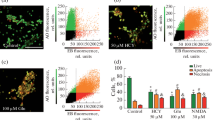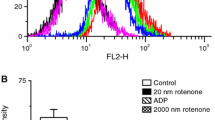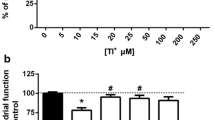Abstract
Effects of dopamine on the membrane permeability transition, thioredoxin reductase activity, production of free radicals and oxidation of sulfhydryl groups in brain mitochondria and the Ca2+ uptake by Na+-Ca2+ exchange and sulfhydryl oxidation in brain synaptosomes were examined. The brain mitochondrial swelling and the fall of transmembrane potential were altered by pretreatment of dopamine in a dose dependent manner. Depressive effect of dopamine on mitochondrial swelling was reversed by 10 μg/ml catalase, and 10 mM DMSO. The activities of thioredoxin reductase in intact or disrupted mitochondria were decreased by dopamine (1-100 μM), 25 μM Zn2+ and 50 μM Mn2+. Dopamine-inhibited enzyme activity was reversed by 10 μg/ml SOD and 10 μg/ml catalase. Pretreatment of dopamine decreased Ca2+ transport in synaptosomes, which was restored by 10 μg/ml SOD and 10 mM DMSO. Dopamine (1-100 μM) in the medium containing mitochondria produced superoxide anion and hydrogen peroxide, while its effect on nitrite production was very weak. The oxidation of sulfhydryl groups in mitochondria and synaptosomes were enhanced by dopamine with increasing incubation times. Results suggest that dopamine could modulate membrane permeability in mitochondria and calcium transport at nerve terminals, which may be ascribed to the action of free radicals and the loss of reduced sulfhydryl groups.
Similar content being viewed by others
References
Schapira AVH, Cooper JM, Dexter D, Clark JB, Jenner P, Marsden CD: Mitochondrial complex I deficiency in Parkinson's disease. J Neurochem 54: 823–827, 1990
Simonian NA, Coyle JT: Oxidative stress in neurodegenerative diseases. Annu Rev Pharmacol Toxicol 36: 83–106, 1996
Graham DG, Tiffany SM, Bell WR, Gutknecht WF: Autoxidation versus covalent binding of quinones as the mechanism of toxicity of dopamine, 6-hydroxydopamine, and related compounds towards C1300 neuroblastoma cells in vitro. Mol Pharmacol 14: 644–653, 1978
Graham DG: Catecholamine toxicity: A proposal for the molecular pathogenesis of manganese neurotoxicity and Parkinson's disease. Neurotoxicology 5: 83–95, 1984
Olanow C, Arendash G: Metals and free radicals in neurodegeneration. Curr Opin Neurol 7: 548–558, 1994
Freeman BA, Crapo JD: Biology of disease: Free radicals and tissue injury. Lab Invest 47: 412–426, 1982
Cohen G, Farooqui R, Kesler N: Parkinson disease: A new link between monoamine oxidase and mitochondrial electron flow. Proc Natl Acad Sci USA 94: 4890–4894, 1997
Offen D, Ziv I, Sternin H, Melamed E, Hochman A: Prevention of dopamine-induced cell death by thiol antioxidants: Possible implications for treatment of Parkinson's disease. Exp Neurol 141: 32–39, 1996
Lai C-T, Yu PH: Dopamine-and L-β-3,4-dihydroxyphenylalanine hydrochloride (L-DOPA)-induced cytotoxicity towards catecholaminergic neuroblastoma SH-SY5Y cells. Effects of oxidative stress and antioxidative factors. Biochem Pharmacol 53: 363–372, 1997
Spencer JP, Jenner A, Aruoma OI, Evans PJ, Kaur H, Dexter DT, Jenner P, Lees AJ, Marsden DC, Halliwell B: Intense oxidative DNA damage promoted by L-DOPA and its metabolites. Implications for neurodegenerative disease. FEBS Lett 353: 246–250, 1994
Pezzella A, d'Ischia M, Napolitano A, Misuraca G, Prota G: Iron-mediated generation of the neurotoxin 6-hydroxydopamine quinone by reaction of fatty acid hydroperoxides with dopamine: A possible contributary mechanism for neuronal degeneration in Parkinson's disease. J Med Chem 40: 2211–2216, 1997
Luo Y, Umegaki H, Wang X, Abe R, Roth GS: Dopamine induces apoptosis through an oxidation-involved SAPK/JNK activation pathway. J Biol Chem 273: 3756–3764, 1998
Spencer JP, Jenner A, Butler J, Aruoma OI, Dexter DT, Jenner P, Halliwell B: Evaluation of the pro-oxidant and antioxidant actions of L-DOPA and dopamine in vitro: Implications for Parkinson's disease. Free Rad Res 24: 95–105, 1996
Li CL, Werner P, Cohen G: Lipid peroxidation in brain: interactions of L-DOPA/dopamine with ascorbate and iron. Neurodegeneration 4: 147–153, 1995
Clark JB, Nicklas WJ: The metabolism of rat brain mitochondria. Preparation and characterization. J Biol Chem 245: 4724–4731, 1970
Hajós F: An improved method for the preparation of synaptosomal fractions in high purity. Brain Res 93: 485–489, 1975
Uyemura SA, Santos AC, Mingatto FE, Jordani MC, Curti C: Diclofenac sodium and mefenamic acid: Potent inducers of the membrane permeability transition in renal cortex mitochondria. Arch Biochem Biophys 342: 231–235, 1997
Rigobello MPR, Callegaro MT, Barzon E, Benetti M, Bindoli A: Purification of mitochondrial thioredoxin reductase and its involvement in the redox regulation of membrane permeability. Free Rad Biol Med 24: 370–376, 1998
Flohe L, Gunzler WA: Assays of Glutathione Peroxidase. In: L. Packer (ed). Methods Enzymol 105, Academic Press, 1984, pp 114–121
Åkerman KEO, Heinonen E: Qualitative measurements of cytosolic calcium ion concentration within isolated guinea pig nerve endings using entrapped arsenazo III. Biochim Biophys Acta 732: 117–121, 1983
Traylor LA, Mayeux PR: Nitric oxide generation mediates lipid A-induced oxidant injury in renal proximal tubules. Arch Biochem Biophys 338: 129–135, 1997
Piedad RT, Javier L, Mercedes GR, Manuel RP, Diego RP: Oxidant/ antioxidant balance in isolated glomeruli and cultured mesangial cells. Free Rad Biol Med 22: 49–56, 1997
Hevel JM, Marletta MA: Nitric-oxide synthase assays. In: Packer L (ed). Methods Enzymol, vol. 233. Academic press, 1994, pp 250–258.
Hung HC, Lee EHY: MPTP produces differential oxidative stress and antioxidative responses in the nigrostriatal and mesolimbic dopaminergic pathways. Free Rad Biol Med 24: 76–84, 1998
Garris PA, Ciolkowski EL, Pastore P, Wightman RM: Efflux of dopamine from the synaptic cleft in the nucleus accumbens of the rat brain. J Neurosci 14: 6084–6093, 1994
Tretter L, Chinopoulos C, Adam-Vizi V: Enhanced depolarizationevoked calcium signal and reduced [ATP]/[ADP] ratio are unrelated events induced by oxidative stress in synaptosomes. J Neurochem 69: 2529–2537, 1997
Fontana G, Rogowski RS, Blaustein MP: Kinetic properties of the sodium-calcium exchanger in rat brain synaptosomes. J Physiol 485: 349–364, 1995
Reed DJ, Savage MK: Influence of metabolic inhibitors on mitochondrial permeability transition and glutathione status. Biochim Biophys Acta 1271: 43–50, 1995
Bernardi P: The permeability transition pore. ontrol points of a cyclosporin A-sensitive mitochondrial channel involved in cell death. Biochim Biophys Acta 1275: 5–9, 1996
Petit PX, Susin SA, Zamzami N, Mignotte B, Kroemer G: Mitochondria and programmed cell death: Back to the future. FEBS Lett 396: 7–13, 1996
Gunter TE, Pfeiffer DR: Mechanisms by which mitochondria transport calcium. Am J Physiol 258: C755–C786, 1990
Zoratti M, Szabo I: The mitochondrial permeability transition. Biochim Biophys Acta 1241: 139–176, 1995
Lenartowicz E, Wudarczyk J: Enzymatic reduction of 5,5′-dithiobis-(2-nitrobenzoic acid) by lysate of rat liver mitochondria. Int J Biochem Cell Biol 27: 831–837, 1995
Crowder JM, Bradford HF: Inhibitory effects of noradrenaline and dopamine on calcium influx and neurotransmitter glutamate release in mammalian brain slices. Eur J Pharmacol 143: 343–352, 1987
Liu Y, Lasater EM: Calcium currents in turtle retinal ganglion cells. II. Dopamine modulation via a cyclic AMP-dependent mechanism. J Neurophysiol 71: 743–752, 1994
Hauptmann N, Grimsby J, Shih JC, Cadenas E: The metabolism of tyramine by monoamine oxidase A/B causes oxidative damage to mitochondrial DNA. Arch Biochem Biophys 335: 295–304, 1996
Urano S, Asai Y, Makabe S, Matsuo M, Izumiyama N, Ohtsubo K, Endo T: Oxidative injury of synapse and alteration of antioxidative defense systems in rats, and its prevention by vitamin E. Eur J Biochem 245: 64–70, 1997
Sofic E, Lange KW, Jellinger K, Riederer P: Reduced and oxidized glutathione in the substantia nigra of patients with Parkinson's disease. Neurosci Lett 142: 128–130, 1992
Wudarczyk J, Debska G, Lenartowicz E: Relation between the activities reducing disulfides and the protection against membrane permeability transition in rat liver mitochondria. Arch Biochem Biophys 327: 215–221, 1996
Author information
Authors and Affiliations
Rights and permissions
About this article
Cite this article
Kim, K.J., Jang, Y.Y., Hang, E.S. et al. Modulation of brain mitochondrial membrane permeability and synaptosomal Ca2+ transport by dopamine oxidation. Mol Cell Biochem 201, 89–98 (1999). https://doi.org/10.1023/A:1007008417342
Issue Date:
DOI: https://doi.org/10.1023/A:1007008417342




